Bottom line: if you’re looking for a conveniently sized and reliably designed speaker on a budget, you won’t be disappointed with the JBL Go 4. Thanks to its IP67 rating and intuitive app offering adjustable EQ and Auracast connectivity, you won’t feel short-changed. However, there are alternatives out there that offer better sound quality if you can stretch your budget a little.
Pros
- +
IP67 waterproof and dustproof rating
- +
Humble price-tag
- +
Light and compact
Cons
- –
Sound quality won’t blow you away
- –
Hanging loop is small and fixed
- –
Doesn’t deliver on the “punchier bass” claim
Why you can trust TechRadar We spend hours testing every product or service we review, so you can be sure you’re buying the best. Find out more about how we test.
The compact and durable JBL Go 4 makes for a good poolside companion. It’s the latest, May 2024-issue model in the Go range, and is one of the first JBL speakers to feature Auracast, along with the Clip 5 and the Xtreme 4 – both of which are happy members of our best Bluetooth speakers buying guide. It’s reasonably priced at $49.95 / £39.99 / $59.95 and is available to purchase in the US, UK, and Australia from the official JBL website, and from Amazon for $49.95 / £34.99 / AU$59.95 at the time of writing.
The JBL Go 4 comes in Black, White, Red, Blue, Purple, Pink, or Squad (i.e. camo) in the US, UK, and Australia. Additional color variations are available in the US and Australia, including Sand, and Black and Orange – which also has a lot of light blue on it, as it happens. I was given a sample of the Red Go 4 to test out and one thing’s for certain: though it may be little, if you go for this or one of the other bolder colors you won’t lose sight of it easily.
The front and back of the eye-catching little speaker are covered in woven fabric, with silicone panels on the top and sides in which the various buttons and the USB-C charging port are housed, and textured silicone areas on the back and bottom that provide stability whether the speaker is placed upright or on its back. The buttons in the top and left-hand panels include a play/pause button and volume controls, and the power, Bluetooth, and Auracast buttons. I have to give JBL some bonus points for taking a sustainable approach by using recycled fabric and plastic in parts of the speaker, and for using packaging that’s largely paper-based and printed using soy ink.
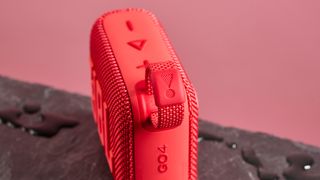
There’s a small fabric and silicone loop fixed around the top-right corner of the speaker that did come in handy, although I needed to use a hook or separate carabiner to hang it from, which was not as helpful as the integrated carabiner on the JBL Clip 5 or the multiway strap on the Sony XB100.
At a dinky size of 3.7 x 3.0 x 1.7 inches / 94 x 78 x 42 mm and weighing just 11oz / 190g, this speaker would make a useful little music companion. Due to its IP67 rating, it’s safe to use at a pool party or at the beach – we can confirm that it continues to work after it’s submerged in water, as we gave it a good dunking in the TechRadar testing tank.
The JBL Portable app is intuitive, and its attractive design makes it satisfying to use and simple to navigate. The app can connect to any compatible JBL speaker, with each speaker displayed on the My Products page (provided they’re powered on). From this page, you can also skip over to the PartyTogether area to add other JBL speakers into the mix for amplified sound.
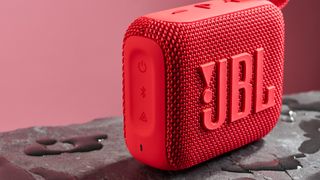
Once I selected the Go 4 from the product page, I could see the battery level and enable PlaytimeBoost, which is designed to boost the volume of the music while consuming less battery by disabling the EQ. There’s also a Product Information section, Stereo Group mode for connecting two speakers together in stereo, and the four preset equalizer profiles: JBL Signature, Chill, Energetic, and Vocal, plus the Custom EQ profile.
The stated battery life of the Go 4 is seven hours. Now, I’m used to some speakers not quite going the distance, which is often covered by caveats on the brand’s website; however, this speaker went above and beyond, lasting for nearly 10 hours of continuous music playing at 50% volume on the default JBL signature EQ preset.
At one point I experienced a small issue when the Go 4 wouldn’t play music from our FiiO M11S music player or a Samsung Galaxy Z Flip 4. Both devices could connect to the Go 4 and were shown as playing music, but no sound was coming out of the speaker. Taking a leaf out of the operations manual of IT help desks everywhere, I turned the speaker off and on again, and fortunately that fixed the issue straight away.
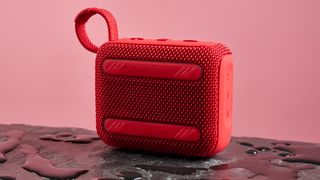
The overall listening experience was fine; nothing groundbreaking, but perfectly adequate for the price. When music is played using the default JBL Signature EQ profile the depth and clarity are lacking somewhat, but I was able to make improvements by implementing the other EQ presets or by employing a custom EQ. If you’re used to higher-end speakers, you may find this lower-quality sound a chore to listen to, but for those who just want something compact that they can throw in a bag when they want to enjoy tunes on the go, it’s great.
This tiny speaker can reach a good level of volume for its size. At 50% it’s loud enough to dance around your kitchen to, but if you’re doing any noisy cooking you may need to bump it up a bit. The speaker’s orientation makes a noticeable difference to the sound quality, particularly for tracks with high levels of treble or bass. Most users would naturally want to stand it on its base as advertised, but I found that the best sound was achieved with the speaker lying on its back. This is also the best position if you’re listening with others, as the sound is firing upward rather than in one direction.
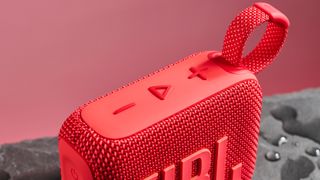
When listening to Black Eye by Allie X, I found the bass wasn’t dynamic enough, and the beat fell flat so the track lost the powerful rhythm that’s usually present when listening through more bass-heavy alternatives such as the Tribit XSound Plus 2 speaker. The vocals also got a little lost amid the different elements as they all seemed to fight for center stage.
I tried the Vocal EQ to see if it would make an improvement, but I found it instead distorted all elements of the track, so it appears this setting wouldn’t be a great one to use when listening to music. There was a slightly noticeable increase in vocal clarity and prominence when enabled for podcasts and other vocal-focused content, however. Going back to Black Eye, the best EQ profile by far was Energetic – the vocal clarity was much improved, and the other elements sounded like they’d been pushed back in line.
The same was true when listening to St. Thomas by Sonny Rollins, and I Want You by Moloko. On the default JBL Signature EQ, everything felt flat, but the Energetic preset does exactly what it says on the label, giving everything a little boost where needed.
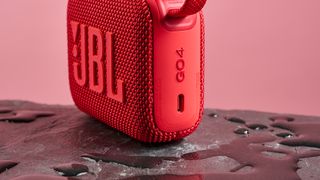
The JBL Signature EQ was adequate for listening to slower and more relaxing tracks, and the output was softened further after switching to the Chill EQ preset, which pulls the highs down so you aren’t hit with any harsh notes when you’re trying to unwind. This EQ delivered a pleasant listening experience when playing Where’s My Love (Alternative Version) by SYML.
Overall, if you aren’t particularly fussed about sound quality and you’re just looking for a cheap and cheerful little speaker that’s durable enough to handle a rainy day or a beach party, the JBL Go 4 is a solid choice. There are a lot of good alternatives available though, so I’d recommend checking out our selection of the best waterproof speakers and best cheap Bluetooth speaker deals to see if anything else catches your eye.
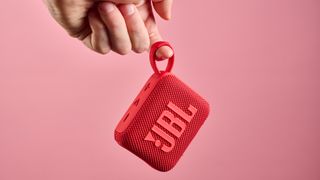
JBL Go 4 review: Price and availability
- $49.95 / £39.99 / $59.95
- Available now in the US, UK, and Australia
Released in May 2024, the JBL Go 4 is the latest model in the JBL Go range, following on from the Go 3. It’s available for purchase from the official JBL website for $49.95 / £39.99 / AU$59.95, and from Amazon for $49.95 / £34.99 / AU$59.95 at the time of writing.
As mentioned, it has plenty of competition in this price range – in particular, there’s the five-star rated Tribit Stormbox Micro 2 that massively impressed our reviewer considering the $59.99 / £59.99 price tag. However, if your budget maxes out at $50 / £40 and you just want something small, durable, and a bit jazzy, then the JBL Go 4 is a good choice.
JBL Go 4 review: Specs
Swipe to scroll horizontally
| Row 0 – Cell 0 | Row 0 – Cell 1 |
| Dimensions | 3.7 x 3.0 x 1.7 inches / 94 x 78 x 42mm |
| Weight | 6.7oz / 190g |
| Connectivity | Bluetooth 5.3, USB-C (charging) |
| Battery life (quoted) | 7 hours |
| Waterproof rating | IP67 |
| App available | Yes |
Should I buy the JBL Go 4?
Swipe to scroll horizontally
| Section | Notes | Score |
|---|---|---|
| Features | The intuitive JBL Portable app with adjustable EQ and Auracast connectivity scores this low-cost speaker some points. | 4/5 |
| Sound quality | For the cost, the sound quality isn’t terrible, especially if you take the time to play with the EQ settings, but we’ve seen better in this price range. | 3.5/5 |
| Design | I’m loving the choice of colors and the fact that JBL has used recycled materials in some areas. The only real negative for me is that there’s only a hanging loop, not a strap. | 4/5 |
| Value | With a bit more investment you can get better sound quality, but for less than $50 this speaker doesn’t under-deliver. | 4/5 |
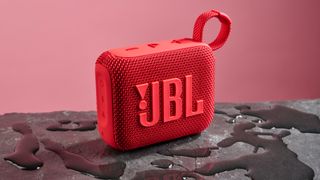
Buy it if…
This speaker is little and light, so you can easily throw it into your bag or put it in a pocket ready for when you want to listen to some tunes on your travels.
It’s available in a range of stylish colors, and if you go for one of the bolder options you won’t easily lose sight of the Go 4, despite its small size.
